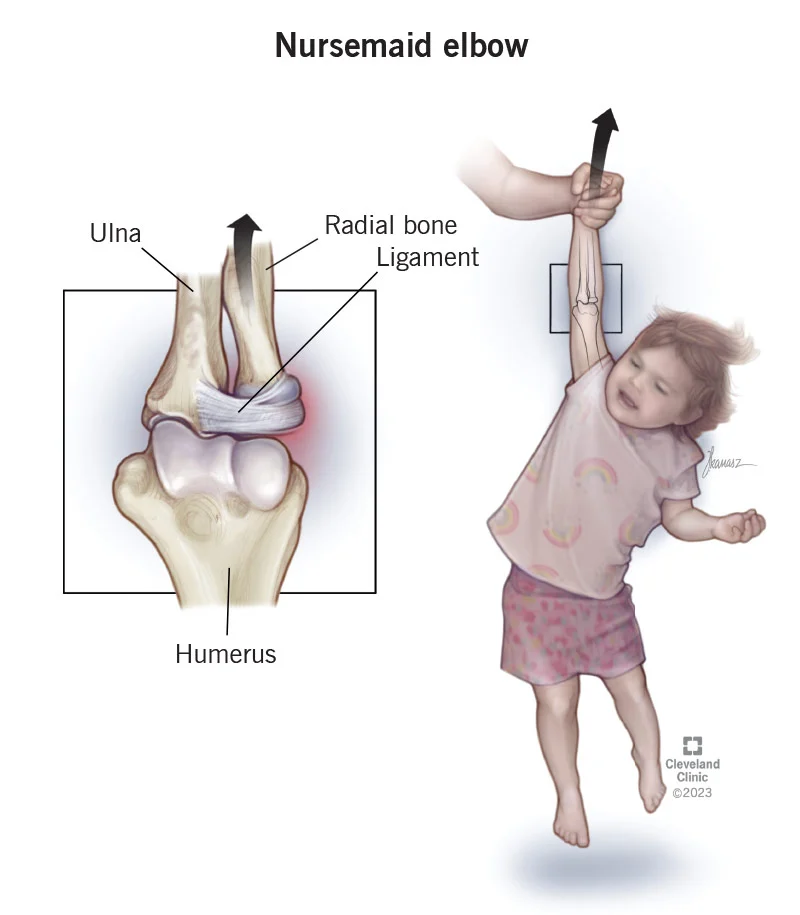Nursemaid’s elbow, or radial head subluxation, is a common childhood injury when the forearm bone slips out of place at the elbow. Typically occurring in children under four, it often results from a sudden pull or tug. While not usually serious, prompt medical attention is crucial. Treatment involves a gentle maneuver by a healthcare professional to restore the joint. Dr. Bornstein discusses the causes, symptoms, and treatment for nursemaid’s elbow.

DEFINITION:
Nursemaid’s elbow is a common elbow injury in children caused by the child being pulled by the forearm
SYMPTOMS:
Pain in the elbow with the child holding the arm flexed against the body or the hand facing downward to the floor.
CAUSES:
It is caused by a quick yank to the forearm. A ligament called the annular ligament on the head of the radius (a bone of the forearm) gets pinched between the radius and the humerus (the bone between the elbow and the shoulder).
In a pulled elbow, the annular ligament around the radial head (left) is dislodged when the arm is pulled (middle), partially dislocating into the radiocapitellar joint when the arm is released (right).

DIAGNOSIS:
The diagnosis is made based on the history of the pull to the arm, along with the child holding the arm in a typical position. An x-ray can be done to rule out any fracture, but this is not usually necessary.
TREATMENT:
To reduce the annular ligament, stabilize the elbow from below, using the thumb to apply light pressure over the radial head. Firmly rotate the forearm to the palm-up position (1). This may create a sense of mechanical blockage, followed by a palpable pop at the elbow. If supination alone does not produce a palpable pop and improve motion, supinate the forearm and fully flex the elbow (2).
The arm can be maneuvered to allow the annular ligament to snap back and return to its original position. Usually, a physician will do this. The hand can be quickly turned upward, and elbow flexed. If your hand is on the elbow, you can feel a click as the ligament returns to its normal position.
OUTCOME:
Excellent. The most common complication is recurrence.
PREVENTION:
Nursemaid’s elbow can be prevented by not pulling or lifting a child by the hands or wrists or swinging them by the arms. Instead, lift the child by grasping their body under the arms.
DISCUSSION:
Nursemaid’s elbow is a common elbow injury in children. Typically, a child is about to run across the street when they are pulled back. It is common for the parent to lift the child by the hands, causing sudden pain in the elbow. It usually happens in children less than four years of age. A simple maneuver will fix the problem, and the child will almost always get immediate relief.
ONE DOCTOR’S OPINION:
Nursemaid’s elbow always makes me look like a hero. Whenever a child is brought in with an arm injury, everyone assumes it’s broken. But the truth is that the child has simply dislocated their elbow. I take their hand and turn it upwards, feeling the click in the elbow when I bend it. Within a minute, I am able to fix it. The child can use their arm again with no problems. The parents leave, relieved their child is okay and happy they don’t need a cast.
This blog was written by Dr. Michael Bornstein, who has 30 years of experience as a pediatrician.
Disclaimer: The contents of this article, including text and images, are for informational purposes only and do not constitute a medical service. Always seek the advice of a physician or other qualified health professional for medical advice, diagnosis, and treatment.


FOLLOW US